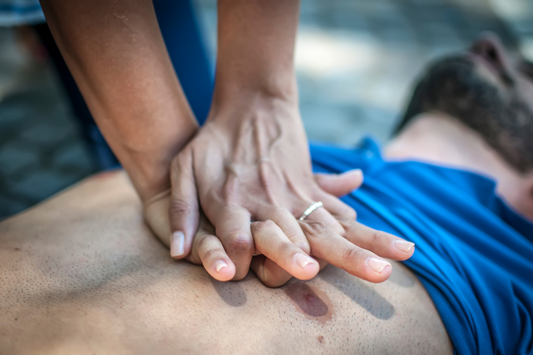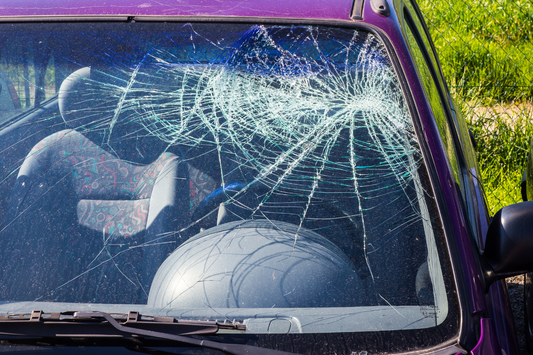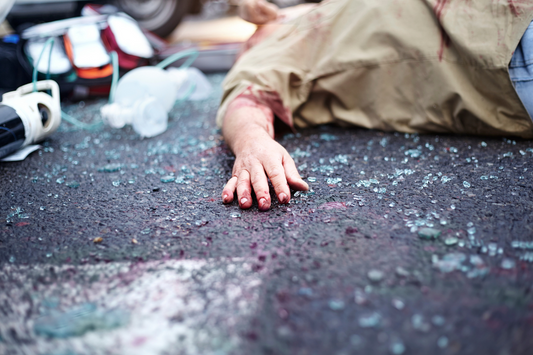As a mother to four daughters I have experienced first hand, the paralysing fear of my own child choking.
Distracted by hosting a backyard BBQ, my 18 month old climbed into the pantry and grabbed a packet of 2 minute noodles.
She was walking in front of me, and stopped suddenIy and started grabbing at her neck.
As I watched her coughing I saw the fear on her face as she turned bright red, then quickly turned blue.
Her mouth was filling and overflowing with strings of noodles.
I couldn't move.
This was back in the early 90s before mobile phones. I was a young mum, and had not done a useful first aid class ever. I didn’t know what to do.
I was unable to decide whether to race indoors to call 000, or attempt to help her.
It felt like time was standing still.
Before I could do anything, guest saw what was going on. He clamped one of his huge hands around her tiny ankles and hoisted her upside down. He proceeded to thump on her back between the shoulder blades with his other hand.
I watched horrified, as strings of dry but swollen noodles came out of her throat.
The noodles had swollen up, filled her tummy and began making their way out, causing this choking incident.
Now, the good news is the story ended well.
But this is NOT the recommended treatment for choking! Learn how to give safe and effective first aid for choking, for babies and toddlers. Keep reading and learn.
What is Choking?
28 years on and 16 years as a first aid trainer, I have heard many stories, and fielded lots of questions from my students.
The single most important piece of information I have learned, and now share, is Prevention Prevention Prevention!
Pair up prevention with first and skills, and you can parent with confidence!
Choking is scary, and can be either a partial or a complete obstruction.
Partial obstruction is when the person is still able to breathe a little and has an effective cough.
A full obstruction is when the person is unable to breathe at all.
Read on and learn how to perform the correct first aid to manage choking in babies and children.
Choking Hazards-Toddlers vs Adults
Toddlers:
- Smaller airways: Toddlers have much narrower airways than adults, making them more easily blocked.
- Developing chewing skills: They are still learning to chew and swallow effectively, increasing the risk of choking on poorly chewed food.
- Tendency to put things in their mouths: Toddlers explore the world through their mouths, making them more likely to choke on small objects.
- Types of foods: Round foods (grapes, cherry tomatoes), cylindrical foods (hot dogs, carrots), and hard/sticky foods (nuts, popcorn, marshmallows) are particularly dangerous for toddlers.
Adults:
- Larger airways: Adults have wider airways, making it less likely for food to become completely lodged.
- Developed chewing skills: Adults generally have better control over chewing and swallowing.
- Less likely to put things in their mouths: (Hopefully!) Adults are less prone to putting random objects in their mouths.
- Types of foods: Adults mainly choke on large, poorly chewed pieces of food, especially tough meats or sticky foods like peanut butter. They can also choke on things like fish bones or poorly fitting dentures.
Common Causes of Choking in Children
- Round foods: Grapes, cherry tomatoes, blueberries, and melon balls are the perfect size and shape to block a baby's airway.
- Hard and sticky foods: Nuts, seeds, popcorn, hard candies, marshmallows, and chewing gum can be difficult to chew and swallow, increasing the risk of choking.
- Cylindrical foods: Hot dogs, sausages, carrots, and bananas can easily get lodged in a baby's throat if not cut into small pieces.
- Chunks of food: Large pieces of any food, including meat, cheese, and raw fruits and vegetables, can be choking hazards if not properly chewed. :
- Coins: Small coins are easily swallowed and can get stuck in a baby's esophagus.
- Buttons: Buttons, especially those that are small or have come loose from clothing, can be choking hazards.
- Batteries: Button batteries, found in many household items, are extremely dangerous if swallowed. They can cause serious internal burns.
- Small toys and toy parts: Marbles, beads, small balls, and detachable parts from toys are all potential choking hazards.
- Household items: Hair clips, rubber bands, pen caps, and other small items found around the house can also pose a risk.
Home Hazards Checklist
- 1. Think like them!: The best way to spot hazards is to see the world from a child's perspective. This is easy crawl around each room, see what you can see!
- 2. The Toilet Roll Test: Keep a cardboard toilet paper roll handy. Anything that fits inside the roll is a potential choking hazard for a young child.
3. Room-by-Room Search:
Living Room:
- Check under furniture and between cushions for small items like coins, buttons, beads, hair ties, and jewellery.
- Look for small toys or toy parts, especially from older siblings.
- Examine decorative items like vases or sculptures for loose or detachable parts.
- Be mindful of remotes, game controllers, and electronic devices with small buttons or batteries.
Kitchen:
- Keep small magnets off the fridge.
- Store small food items like nuts, seeds, and dried fruit out of reach.
- Be aware of choking hazards in drawers and cupboards, such as twist ties, rubber bands, and plastic utensils.
- Secure cleaning supplies and chemicals in a locked cabinet.
Bedrooms:
- Check under beds and in toy bins for small toys and objects.
- Keep coins and jewellery out of reach, especially on bedside tables or dressers.
- Be mindful of small items used for crafts or hobbies.
Bathroom:
- Store medications and vitamins in a locked cabinet.
- Keep cosmetics and toiletries out of reach.
- Be aware of small items like hair clips, nail clippers, and cotton buds.
Laundry:
- Store laundry detergents and cleaning products safely.
Keep button batteries and coins out of reach.
Outdoor Areas:
- Check for small stones, pebbles, or mulch in gardens and play areas.
- Be aware of choking hazards in sheds and garages, such as nails, screws, and tools.
- Ongoing vigilance:
- Regularly check for new choking hazards, especially after parties or gatherings.
- Teach older children to keep their small toys away from younger siblings.
- Stay alert for broken toys or objects with small parts that could come loose.
Remember: Prevention is key! By taking these steps, you can create a safer environment for young children in your home.
PREVENTION…PREVENTION…PREVENTION…PREVENTION…PREVENTION…PREVE
Shape Matters:
Cut food into safe sizes and shapes. Do not give young children round foods like grapes and cherry tomatoes, or cylindrical foods like bananas and carrots.
If you do, cut them into quarters or sticks first. Skip risky foods like popcorn, marshmallows, and whole nuts altogether.
- Sit and Eat: Encourage your child to sit down while eating, whether it's a meal or a snack. This helps them focus on chewing and swallowing, reducing the chance of choking. Plus, it's a great opportunity to bond!
- Supervise Always: Never leave your child unattended while eating, even for a moment. Choking can happen silently, so keep a close eye on them at all times.
- Search for Hazards: Get down on your child's level and look around for small objects that could be choking hazards. Anything that fits through a toilet paper tube is a risk! Keep things like coins, buttons, and small toys out of reach.
Is your child choking? Here's what first aid to do:
If they can cough strongly:
- Encourage them to keep coughing. This is the best way to clear the airway.
- Stay close and watch them. Be ready to help if their cough weakens or stops.
If they can't cough or make any sound:
- Stay calm and call for help immediately. (e.g., shout for someone to call an ambulance)
- Lay your baby face down on your lap. Support their head and make sure it's lower than their bottom.
- Give up to 5 firm back blows. Use the heel of your hand to hit between their shoulder blades. Check if the object has come out after each blow.
- If that doesn't work, turn them onto their back. Keep them on your lap with their head lower than their bottom.
- Give up to 5 chest thrusts. Use two fingers for a young baby, or the heel of your hand for an older baby or toddler. Push firmly on their breastbone (not their tummy). Check after each thrust.
- Keep repeating back blows and chest thrusts until the object comes out, help arrives, or they become unconscious.
- If they become unconscious, start CPR. (See how to do CPR for a baby or child - it's important to learn this beforehand!)
Remember: This is a simplified guide. It's best to take a specialised babies and childrens first aid course-I run them here in Dubbo!
REFERENCE: ANZCOR guideline 4.
Remember: Even with precautions, accidents can happen. Learn first aid for choking so you can act quickly in an emergency.
Awesome Resources from CPR Kids
Click here to get your essential choking guide-perfect for your home and the homes of anyone who cares for your kids!
This guide has been produced by the team at CPR Kids-these guys lead the way in education for parents. They taught me everything I know, so I cannot speak highly enough. Sarah has an excellent you tube channel, covering vital info for parenting. I highly recommend taking a look!
So, now you have the knowledge, the guide, the checklist and hopefully the confidence.
Don’t wait until it's too late, book yourself and your kids carers into a childcare first aid class ASAP! You wont regret it.
- HealthInfoNet - Provides valuable insights on indigenous health and safety approaches in Australia.
[healthinfonet.ecu.edu.au](https://www.healthinfonet.ecu.edu.au)
- Royal Children's Hospital Melbourne - Comprehensive child health and safety guidelines.
[rch.org.au](https://www.rch.org.au)
- Sydney Children's Hospitals Network - Provides health resources specific to children’s safety and emergency care.
[schn.health.nsw.gov.au](https://www.schn.health.nsw.gov.au)
- CPR Kids -Paediatric Nurse providing training and education for parents of babies and toddlers in Australia and across the world .



















